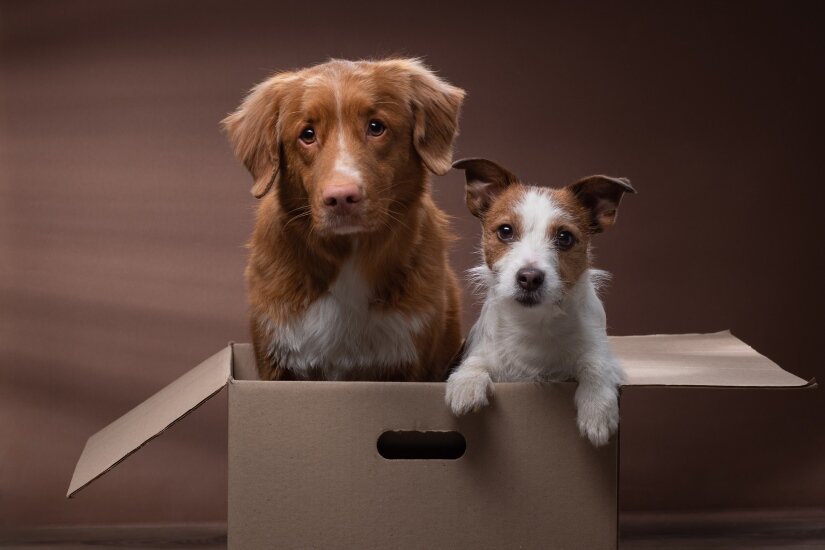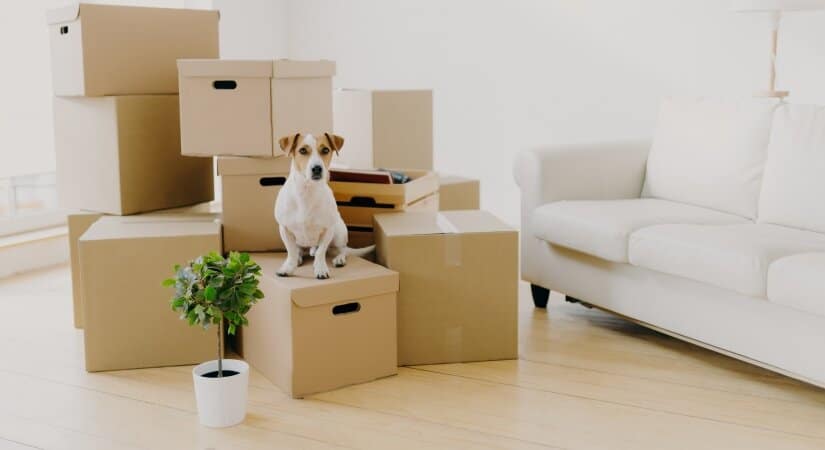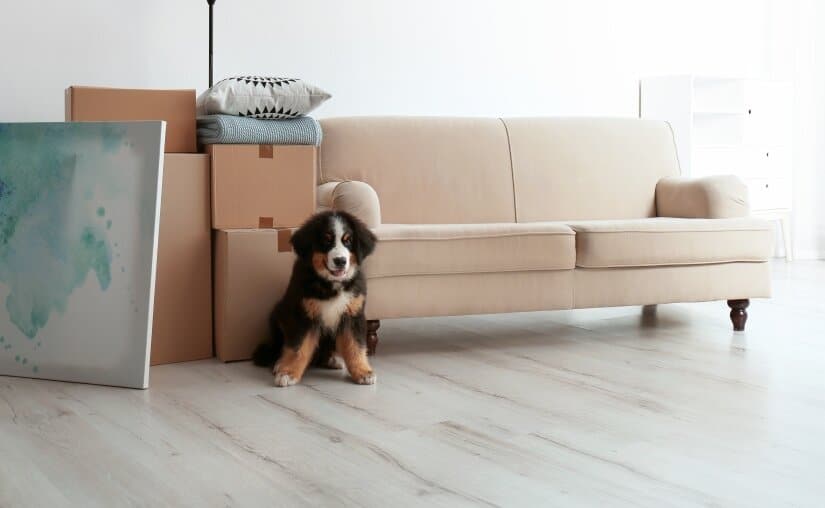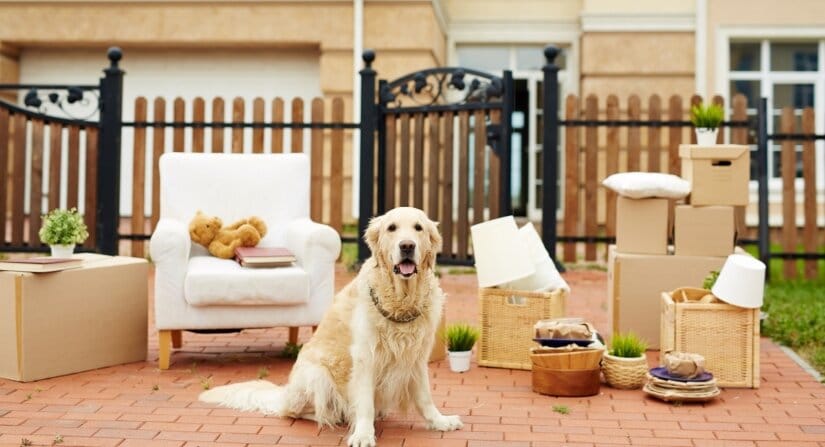There’s no denying that moving house is one of the most stressful events one could go through. However, no one becomes more stressed and anxious about moving into a new house than your beloved pet dog.
Dogs are territorial by nature. New environments may cause them a lot of fear and insecurity. Additionally, as motion sickness is common among animals, long-distance traveling may take its toll on your canine friend.
The good news is, there are many things you can do to ease the stress and anxiety of your pet before, during, and after the big house move! You have to note, though, that while the following techniques may help make the transition much easier for your dog, you cannot completely relieve them of the stress that comes with moving to a new home.
How Can You Tell If Your Dog Is Stressed?
So, you’re ready to be there for your four-legged buddy. Great! However, before you can help him out, you will need to recognize the signs of distress he could be exhibiting.
Most dogs will manifest this stress by looking around anxiously or having their ears flat or close to their head. The latter, in particular may look super adorable, but know that this could mean that something is bothering your pet.
You may also notice your canine friend painting or holding their breath. Both of which are tell-tale signs of stress and anxiety in your dog.
Other signs of distress you should be on the lookout for are:
- Withdrawn behavior
- Tucked tail
- Lethargy
- Excessive licking or drooling
- Diarrhea
- Biting
- Flight-risk tendencies
Preparing Your Dog For The Big Move

As mentioned above, helping ease your dog’s moving-related stress and anxiety does not begin when you leave your old home. It starts days or even weeks before the big move. Here are some ways you can get your dog ready for the big day:
-
1. Keep Their Routine Going
When you’re gearing up for a big move, it’s easy to unintentionally forget your pet’s need for food, exercise, and affection. However, many domestic animals, like dogs, are very dependent on routine and become anxious and insecure when this routine is interrupted.
So, make sure to give your pet a semblance of normalcy throughout the moving process. Don’t forget to feed them when they’re supposed to be fed, set aside some time out of your busy schedule to take them out for a walk, and make sure to leave their toys and bed unpacked for as long as possible.
-
2. Prepare Them For Travel
Like most pets dogs can get skittish when put in moving vehicles. Sometimes, they (just like us humans) get carsick, too. As this will cause extreme stress on your dog, you will want to help them get used to traveling.
In the months or weeks leading up to your move, try to go out on short drives with them in the car. This will get them used to the feeling of being in a moving vehicle and help them acclimate with your car as well.
If you plan on loading your pet in a crate during the journey, it would be best to get them used to it as well. It is important to find the dog crate that will keep your pet relaxed and comfortable despite being in a moving, vibrating car. With that being said, you will want something that provides enough moving room and plenty of ventilation for your pet. To find out what crate is best for your move, read up on the best dog crates here.
Alternatively, a good travel dog bed can also be helpful for the big move. You can easily put it in a less travel-friendly crate, thus making sure that your dog is still relaxed and comfortable on your way to your new home. Here are some tips on finding the perfect dog bed.
-
3. Chat With Your Vet About Using Anxiety Aids
If you’re worried your pet might take the move and the long trip too hard, you may also refer to your vet about using anxiety aids to help out your pet. Anxiety aids may come in the form of medication, collars, treats, or toys. These are usually used for pets who are anxious because of many people in the vicinity, loud fireworks, and sometimes, a change in surroundings.
Easing Your Dog’s Stress During The Move

Here comes the hard part. Moving is already very stressful on its own. Dealing with pets on the big day is going to make things much more difficult! So, to lighten your burden, here are some tips you may find useful:
-
1. Find A Safe Space For Your Dog Amidst The Chaos
Because people will be coming in and out of your home to pack, haul, and move boxes and furniture, so letting your dog loose amidst this chaos would only add to the stress of moving.
You may, instead, find and provide a safe space for your dog during this chaotic time. You may put them in a room with stuff they are familiar with, like their bed and toys. Alternatively, you may assign a member of your household or hire a pet-sitter to tend to your dog during the move.
If you are moving close by, you may choose to leave your pet with a relative, friend, or neighbour who can look after your pet while you focus on getting your new place ready.
-
2. Prepare Small Meals Only
The stress and nerves may get the best of your pet’s stomach, and feeding them small amounts throughout the move will help minimise the chances of your dog having an upset stomach. Furthermore, a full tummy may also be bad for a pet who has the potential to get car sick, and who wants to deal with dog vomit?
This goes without saying, but if your dog does get sick, do not take it out on him. After all, this will only add to the stress he may already be feeling.
-
3. Make The Trip As Comfy As Possible
Keeping your pet relaxed and comfortable during the journey, no matter how long it is, is of utmost importance. Make sure that they are not cramped. This will not only ease their stress, but also keep them safe from objects that may potentially fall on them sometime during the journey.
Allow them to stretch out and get comfortable in your vehicle by refraining from loading any bulky or heavy objects with them in the car. The same applies when you’re using a dog crate. While being enclosed keeps your dog safe from being crushed by heavy objects, items banging or falling onto their crate or carrier may also cause stress.
Instead, you may hire a man and van to transport your stuff for you, as they will handle the hauling and transporting of your things in an efficient and timely manner.
Make sure to find a service provider that offers a vehicle that is sized to accommodate all of your stuff. That way, you won’t have to load anything that isn’t too valuable or fragile in your car.
Another way of keeping your dog comfortable during the trip is by making sure that your vehicle is well-ventilated. Excessive heat or cold may be dangerous to your pet.
Lastly, if you are moving to a faraway place, make frequent stops so that your pet can drink some water, gobble up some treats, stretch for a bit, and do their business.
Helping Your Dog Transition

Getting all moved and settled in is one thing, but getting your dog used to the new place is another. Here are some ways you can help your dog adjust and familiarize themselves with your new house!
-
1. Unpack Your Dog’s Belongings First
As already mentioned, dogs are extremely territorial. Losing this territory is one of the reasons why they become stressed and anxious as they are unsure of where they could eat, sleep, and go to the toilet.
And so, after packing your dog’s stuff last, unpack them first. Giving them this area where they can be familiar with will help speed up the adjustment process.
-
2. Transfer Your Pet’s Scent All Over Your New House
The scent is one of the most significant contributors to helping an animal become familiar with their surroundings. That is why, to help your dog become familiar with the new house, you may practice scent-swapping.
To put it simply, scent-swapping requires you to embed your pet’s scent into your new home. Just rub a piece of cloth onto your pet’s face and rub that cloth onto the corners and furnishings of your new home.
This should help them settle in and acclimate pretty quickly. If all else fails, a bottle of pet pheromones is also something you would want to try.
-
3. Be Patient With Your Dog
Just like when you are bringing a dog home for the first time, helping them adjust and get acquainted in a new home after moving requires a lot of patience and understanding. Do not take out your stress or frustration on your pet if things don’t go as smoothly as you want. Just let them take their time and allow them to take the lead in finding areas of the house that they can call “theirs.”
-
4. Take Some Safety Precautions To Make Sure Your Dog Is Safe
The path to helping your dog adjust and make the transition could be a rocky one. And because you simply cannot tell or control how easily your dog will acclimate to its new surroundings, you should make sure they are still safe.
Some dogs cope with the stress by running away to their new home. To prevent this, you would want to find ways to pet-proof your fence and all possible exit points.
You should also make sure that your pet’s collar and microchip details are up to date so that you can easily find them if they attempt to run away. You are required by the government to keep these up to date anyway, so do it as soon as possible.
